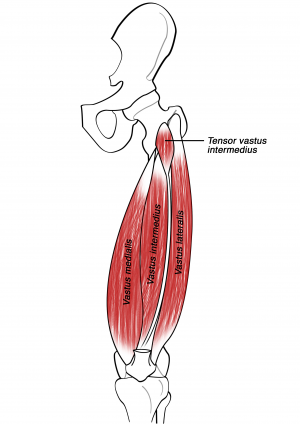Tensor Vastus Intermedius
| Tensor Vastus Intermedius | |
|---|---|
| Hoort bij: | Ventrale bovenbeenspieren |
| Oorsprong: | het proximale gedeelte van het femur met name aan het anterieure gedeelte van de trochanter major |
| Aanhechting: | via de aponeurosis van de vastus intermedius en het mediale aspect van de knieschijf |
| Innervatie: | |
| Functie: | spant de aponeurosis van de vastus intermedius |
 | |
Tensor Vastus Intermedius is a muscle in the anterior compartment of thigh. It lies between the vastus medialis and the vastus lateralis. The structure has been previously reported[1][2] but has not been described nor illustrated in any textbook.[3] The term tensor vastus intermedius was given by Grob et al. in 2016.[3]
Structuur
The tensor vastus intermedius muscle originates from the proximal part of femur specifically from the anterior part of the greater trochanter.[3] The muscle lies anterior to the vastus intermedius but deep to the rectus femoris.The tendinous part of the muscle is closely related to, and sometimes fuses with, the aponeurosis of the vastus intermedius. Distally, it joins the quadriceps tendon and inserts to the medial aspect of the patella.[3] It is supplied by the femoral nerve and the lateral circumflex femoral artery.
Variaties
This muscle is categorised into five types according to morphology: the independent type, VI-type, VL-type, common type and two-belly type.[3] The independent type of the tensor vastus intermedius, also the most frequent type, has its tendon lying between the vastus intermedius and the vastus lateralis. For the VI-type and the VL-type, the tendinous part of the muscle is integrated into the fascia of the vastus intermedius and the vastus lateralis respectively. For the common type, it has a non-separable origin between the intertrochanteric line and greater trochanter. Two separate muscle bellies can be found for the two-belly types.
Functie
The tensor vastus intermedius muscle tenses on the aponeurosis of the vastus intermedius and also medialises the action of the muscle. It also acts as a second tensor in addition to the tensor fasciae latae.
Zie ook
- musculus quadriceps femoris (vierhoofdige dijbeenspier)